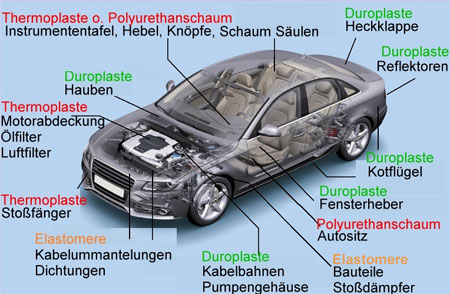Chemistry in everyday life
Chemistry is so much more than a collective term for toxic substances, corrosive chemicals and experiments in the laboratory. Chemistry surrounds us everywhere in everyday life. Whether it's cooking and baking, driving, washing clothes or dyeing hair - chemical reactions are what make our lives possible.
Join us on our journey through chemistry. In this series, we describe everyday situations and completely normal things that are all based on the same principle - chemistry.
A for automobile
Our favourite means of transport and the technology behind it are the result of various chemical reactions and phenomena.
All the materials a car is made of, such as different metals, glass, plastics, paints, adhesives as well as textiles and leather, show us the chemical relationships that underlie the entire car.
Metals
Aluminium, iron and zinc are indispensable in the production of cars today. Aluminium and the steel derived from iron are needed for the car body, the chassis and the equipment. Zinc is present in many different components of a car, from corrosion protection to roof rails, in total there are about 10kg of the base metal in every car.
Glass
In contrast to the side and rear windows, thick laminated safety glass (LSG) with viscoplastic polyvinyl butyral (PVB) films is used for the windscreen so that as few splinters as possible fall off.
The side and rear windows are made of single-pane safety glass (ESG) to make them easier to break in the event of an accident/emergency.
Plastics
The proportion of plastics in cars is increasing. The reasons for this are weight reduction and the associated fuel savings as well as lower production costs compared to metals.
Thermoplastics are used for most of the parts. Due to their heat resistance, they are used in areas with higher temperature loads, e.g. as intake manifolds, oil filter housings, cylinder head cover, engine cover and air filter.
High temperature thermoplastics are processed for cable trays or pump housings. Body parts such as mudguards or bumpers as well as various interior parts can also be made of either thermoplastics or polyurethanes. Thermosets are used in much smaller quantities. They are needed where high thermomechanical strength is required, e.g. for water pump housings, cable trays and reflectors. Elastomers are used more covertly, mainly in seals and cable sheathing as well as in shock absorbers.

Source: chemie-am-auto.de
Paints & adhesives
The most striking thing about a car is its paintwork. It is one of the most important factors in determining how eye-catching a car is and how it is perceived.
Adhesives now also make a decisive contribution to the stability of a car body, e.g. by bonding body panels, windscreens and rear windows that used to be held in place by elastomer seals, or reinforcements/stiffeners for doors, side panels, shock absorbers and at various crash points.
Classic fuels
The classic fuels such as diesel and super petrol are derived from crude oil. Due to its formation from organic material in the absence of air, petroleum consists of hydrocarbon compounds. Petrol, known to motorists as petrol or super petrol, is a mixture of straight, branched and ring-shaped hydrocarbons with 5-9 carbon atoms. Diesel fuel consists of straight, branched and ring-shaped hydrocarbons with 10-22 C-atoms.
Alternative fuels
Biodiesel is offered at various petrol stations and is therefore the best known. It is produced almost exclusively from rapeseed oil, although used cooking oil and animal fats can also be used.
- Bioethanol: Bioethanol is also an alternative fuel. It is produced by fermentation from plants containing sugar and starch, e.g. cereals: wheat, rye, maize, potatoes, sugar cane, wood (rarely).
- Biomethane/biogas: produced by anaerobic degradation of organic matter by microorganisms: cattle and pig manure, fodder beet, silage maize, pasture grass, biowaste, food waste, waste fats, animal by-products.
- LPG - Liquefied Petroleum Gas: LPG is obtained during oil production, in refineries and also as a by-product of natural gas production. The exhaust gas values of LPG are significantly more favourable than those of petrol in terms of CO2 and nitrogen oxide emissions, and it also produces fewer unburned hydrocarbons. As long as petroleum is used for fuel production, LPG is a sensible and environmentally friendly addition to the range.
- Hydrogen: Cars that do not need fossil fuels but fill up with hydrogen and run on a fuel cell and an electric motor instead of an internal combustion engine are the vision for the new millennium. A fuel cell for a car is hardly bigger than a car battery. In it, hydrogen and oxygen react to form water; electrical energy and heat are released in the process.

www.donauchem.at
Related Links:
www.chemie-am-auto.de
www.mein-autolexikon.de